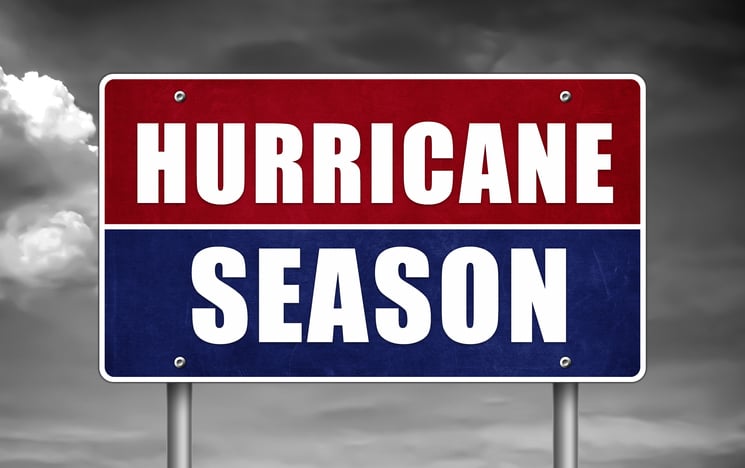Invictus Tariff and Trade War Recession Scenario
The Invictus Tariff and Trade War Recession 2.0 scenario (updated August 19, 2025) is intended to reflect (but not predict) a tail-risk outcome for the U.S. economy, driven by...

The United States is no stranger to the fury of hurricanes. These massive, destructive storms can wreak havoc on communities, businesses, and infrastructure. As we look ahead to the 2023 hurricane season, the National Oceanic and Atmospheric Administration (NOAA) forecasts an unsettling outlook: 12 to 17 named storms, with the potential for five to nine of them to evolve into hurricanes. Of those hurricanes, one to four could reach the dreaded status of major hurricanes, defined by the Saffir-Simpson Hurricane Wind Scale as Category 3, 4, or 5. These are storms with wind speeds ranging from 111 mph to 157 mph and higher, capable of causing catastrophic property damage and prolonged power outages. In this blog post, we will explore why US community banks should be acutely aware of the risks hurricanes pose to their business and the communities they serve.
Hurricanes are not just natural disasters; they are also economic disruptors. When a major hurricane strikes, it can lead to extensive property damage and infrastructure destruction. Homes and businesses may be reduced to ruins, leaving communities grappling with the immense financial burden of recovery.
Community banks are intimately connected to the well-being of the neighborhoods they serve. When businesses and homes suffer losses, borrowers may struggle to make loan payments. This can lead to an increase in non-performing loans, affecting the bank's asset quality and overall financial stability. In such situations, community banks may find themselves navigating treacherous waters, making it essential to understand the hurricane risks they face.
Hurricanes can throw a wrench into the day-to-day operations of community banks. Infrastructure damage, power outages, and transportation difficulties can hinder the bank's ability to provide essential banking services. ATMs may be rendered inoperable, branches may need to close temporarily, and online banking systems could experience downtime. These disruptions can result in a loss of revenue, damage to customer relationships, and increased operational costs.
Furthermore, access to physical bank branches becomes crucial for customers in times of crisis. They may need to conduct essential financial transactions, access funds, or seek assistance. Being prepared to operate during and after a hurricane is not just a matter of business continuity but also a demonstration of a bank's commitment to its community.
After a major hurricane strikes, affected communities often turn to banks for financial assistance to rebuild and recover. Community banks may experience a surge in loan requests, ranging from personal loans for home repairs to business loans for rebuilding damaged enterprises. While this presents an opportunity for banks to support their communities, it also poses challenges.
Managing the increased demand for credit while maintaining prudent underwriting standards is a delicate balance. Banks must ensure that they have the resources and capacity to evaluate and process loan applications efficiently. Additionally, they must be vigilant in assessing the creditworthiness of borrowers, given the economic uncertainty that follows a major hurricane.
Community banks must adopt a proactive approach to risk management in hurricane-prone areas. This involves regularly assessing the bank's exposure to hurricane risks and making necessary adjustments to risk management practices. Diversifying loan portfolios to reduce concentration risk in vulnerable regions is one such strategy.
Moreover, understanding the collateral securing loans in hurricane-prone areas is essential. If the collateral is at risk of being damaged or destroyed in a hurricane, the bank needs to assess the potential impact on loan repayment and take appropriate measures to mitigate risk.
Regulatory authorities, including the Federal Reserve and the Office of the Comptroller of the Currency (OCC), closely monitor the financial stability of banks. In the aftermath of a major hurricane, regulators may require banks to conduct stress tests or reassess their risk management practices. Non-compliance with regulatory requirements can lead to regulatory actions and penalties, further underscoring the importance of being prepared for hurricane risks.
What does the Data tells us about Hurricane Risks?
While the geographic regions in the US that are most exposed to hurricanes are well known, the increasing frequency and severity of these events may mean that communities that have not dealt with these events historically, may have to in the future. At the Invictus Group, we are concerned about two key factors (a) What happens when in what happens when insurers no longer insure hurricane risk as we are seeing increasingly in parts of Florida and (b) What happens if the government changes its definition of what classifies as a National Emergency?
With the increasing severity and frequency of climate related disasters, the risk traditionally taken by the insurance market is likely to pass the risk to lenders unless we see the government step in as an insurer in the absence of private insurance coverage. Homeowners may have to rely more heavily on government assistance programs after a hurricane. This can strain public resources and potentially result in higher taxes for residents.
Using deposits as a proxy for loans, we can get an indication of the banks that are most exposed to hurricane risk in the US. For banks lending in hurricane-prone areas, it's crucial to understand homeowners insurance options and ensure that their borrowers have adequate coverage for hurricane-related risks. This may involve homeowners seeking coverage from specialized insurers, purchasing additional policies like flood insurance, or exploring government-backed insurance programs where available. Additionally, homeowners could be required to take proactive steps to mitigate hurricane risks by implementing structural improvements and disaster preparedness measures to protect their homes. All of this to say that Banks credit decisions will need to put greater emphasis on climate related risks going forward.
Conclusion
As the 2023 hurricane season looms, US community banks must prioritize hurricane preparedness to safeguard their operations and the communities they serve. Major hurricanes, with their potential for widespread destruction, can have far-reaching economic and operational consequences. By investing in disaster recovery planning, risk assessment, insurance coverage, customer communication, employee training, and regulatory compliance, community banks can better navigate the challenges posed by hurricanes and continue to play a vital role in supporting their communities during times of crisis. It's not just about weathering the storm but also about being a reliable anchor when it matters most and having safeguards in place with enhanced credit processes to protect banks and their customers.
If you are interested to learn about your banks’ exposure to hurricanes and other climate related risks, the Invictus Group has developed a suite of reports to help you connect your loan portfolio data with climate risk data to help you better understand this and other climate related risks. Contact climate@invictusgrp.com.
Article by Avik Ray, Director, Climate Risk Analytics & Lauren Hill, Climate Risk Analyst.
To learn more about this product visit the climate risk analytics home page or contact climaterisk@invictusgrp.com

CECL Trends, CECL, community bank regulations, community banks, CECL Modeling, acl challenges, bank regulatory compliance, advanced cecl
Now that most community banks have eight to ten quarters of CECL experience under their belts, many are still grappling with foundational issues such as overreliance on qualitative factors, lack of responsiveness to risk rating...

capital planning, community bank regulations, Deregulation, bank strategy, community banks, regulatory capital, bank growth strategy, cre risk
Author : Adam Mustafa, CEO, Invictus Analytics
Community banks now have the clearest path in nearly two decades to reshape their regulatory capital requirements—and they shouldn't miss it. While most recent efforts to ease...